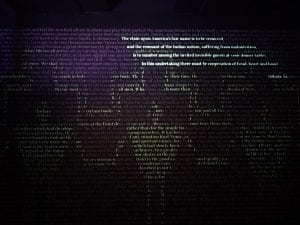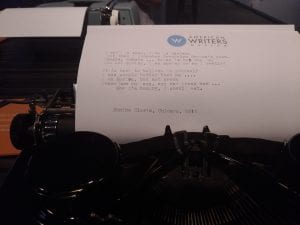Sit down. Inhale. Exhale.
– Gwendolyn Brooks, “To the Young Who Want to Die”
“I’m planning to bring you to the American Writers Museum in Chicago,” said Beth Morrissey, the Assistant Director of Arryman Scholars Initiative. “YES, PLEASE!” I might sound a little bit over-enthusiastic. For someone who knows about the U.S. from afar, some U.S. writers have a significant influence on me. I read Moby Dick, a classic novel by Herman Melville, in my junior high school, but I had no idea about how to read it besides enjoying its great sea adventure and the battle of life-and-death with the white whale (it slightly reminds me of Jonah’s story in the Bible). A few years later, when I became more advanced on reading English book, I found that the novel actually gives an experience; a part of me was floating with the ship, crossing the sea facing the mighty giant that pull me to be intimate with it. Beth’s offer to me and my dear friend, Ara, to go to the museum, recalls my memory about the time I was able to appreciate English, particularly the U.S. literature
The American Writers Museum is located on the downtown of Chicago, on the busy Michigan street where the babel towers eclipse the summer sky. It is not a big, wide museum, but I could sense an intimate feeling. After paying the ticket, we went to a gallery room of children’s literature, and Maurice Sendak’s Where the Wild Things Are was there along with Dr. Seuss’ Cat in the Hat and E. B. White’s Charlotte’s Web. What a lovely first impression.
Near the children gallery, we saw a big map of the U.S.A projecting a visual profile of writers across the country. “Nation of Writers” so it says, and on its right side is the central content of this museum: an alley of 100 writers from the era of 1600s, writers across periods, their forms of writing (political speech, folklore, autobiography, memoir, food writing), powerful quotes, and, what I really appreciate, some literary comments toward the text. The museum does not only introduce or expose the historical fact of American writers—who are they, where they live, what they write—but also provides us a brief way of reading their works, closely and critically.
Across the wall of writers is the shelf of surprises where you can see another set of authors and their words. When you open each shelf, you will see a writing explanation about the author and sometimes a video, a sound, or a smell (believe me, the garlic smell in one of the shelves is unforgettable). At the end of the alley, there is another visual projection, namely word waterfall, exposing quotes in motion by using a lightning effect. It is definitely pretty and moving, like a dance; the words dance, playing around, sharing images, and take a pause on something powerful like George Carlin’s “That’s why they call it American Dream, because you have to be asleep to believe it.”
After that, we continued to the reader corner and writer corner where both have interactive activities for the visitors. On the reader corner, the visitors can make a list of their favorite books (my first choice was Zora N. Hurston’s Their Eyes Were Watching God) and on the writer corner, we can write something using the typewriter and put it on the wall with other visitor’s writing. I did romanticize the idea of putting random words in certain place, so I did my own: started with an almost-sad rant, but then ended up with the reversed version of Dr. Seuss’ “green eggs and ham” because I was hungry (I wrote it “green ham and egg.” Silly me).
Ara also enjoyed his time typing a letter, and after the visit, Beth said, “It was really cool.” Couldn’t agree more with her. We think that the museum is well-curated; we do not see white-male authors only, but also great numbers of women and colored authors. I am very content reading Zora N. Hurston’s profile right in the middle of other white-male authors like T. S. Eliot and F. Scott Fitzgerald. It is indeed a chronological consideration, but it still conveys a strong message about the significance of long-abandoned voices in the U.S. history. We hope the museum could expand the list of writers, because I think, personally, Ursula K. Le Guin should be on the list as well.
Finally, Chicago is a dynamic city and it has a really strong (local) history of literature and influential authors—among others Gwendolyn Brooks, Carl Sandburg, and Saul Bellow—whose writings are powerful, beyond time and space, reaching their own people’s heart and inspiring many to read, to write, to struggle.


